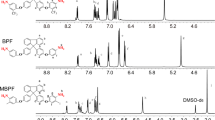Abstract
Polyimides were synthesized using 3,3′,4,4′-biphenyltertracarboxylic dianhydride, (BPDA), tetraethylenepentamine (TEPA) and tris(2-aminoethyl)amine (TAEA) and tested for CO2 adsorption. They were characterized by FT-IR, TGA, DSC and BET techniques. The polyimides were thermally stable upto 400 °C. The polyimide, P2 with significant amount of TEPA and TAEA exhibited higher CO2 adsorption of about 6 wt% at 30 °C than others. The polyimide with only TEPA or TAEA exhibited lower CO2 adsorption. Hence, presence of both the amines is important for high CO2 uptake.
Access this chapter
Tax calculation will be finalised at checkout
Purchases are for personal use only
Preview
Unable to display preview. Download preview PDF.
Similar content being viewed by others
References
Keeling, C.D., Whorf, T.P., Wahlen, M., Plichtt, J.V.D.: Interannual Extremes in the Rate of Rise of Atmospheric Carbon Dioxide since 1980. Nature 375, 666–670 (1995)
Ding, Y., Alpay, E.: Equilibria and Kinetics of CO2 Adsorption on Hydrotalcite Adsorbent. Chem. Eng. Sci. 55, 3461–3474 (2000)
Lee, K.B., Beaver, M.G., Caram, H.S., Sircar, S.: Reversible Chemisorbents for Carbon Dioxide and Their Potential Applications. Ind. Eng. Chem. Res. 47, 8048–8062 (2008)
Bonenfant, D., Kharoune, M., Niquette, P., Mimeault, M., Hausler, R.: Advances in Principal Factors Influencing Carbon Dioxide Adsorption on Zeolites. Sci. Technol. Adv. Mater. 9, 1–7 (2008)
Guo, B., Chang, L., Xie, K.: Adsorption of Carbon Dioxide on Activated Carbon. J. Natural Gas Chem. 15, 223–229 (2006)
Millward, A.R., Yaghi, O.M.: Metal-Organic Frameworks with Exceptionally High Capacity for Storage of Carbon Dioxide at Room Temperature. J. Am. Chem. Soc. 127, 17998–17999 (2005)
Liang, Z., Fadhel, B., Schneider, C.J., Chaffee, A.L.: Stepwise Growth of Melamine-Based Dendrimers into Mesopores and Their CO2 Adsorption Properties. Micropor. Mesopor. Mater. 111, 536–543 (2008)
Fadhel, B., Hearn, M., Chaffee, A.: CO2 Adsorption by PAMAM Dendrimers: Significant Effect of Impregnation into SBA-15. Micropor. Mesopor. Mater. 123, 140–149 (2009)
Lu, W., Sculley, J.P., Yuan, D., Krishna, R., Wei, Z., Zhou, H.-C.: Polyamine-Tethered Porous Polymer Networks for Carbon Dioxide Capture from Flue Gas. Angew. Chem. Int. Ed. 51, 7480–7484 (2012)
Ben, T., Ren, H., Ma, S., Cao, D., Lan, J., Jing, X., Wang, W., Xu, J., Deng, F., Simmons, J.M., Qiu, S., Zhu, G.: Targeted Synthesis of a Porous Aromatic Framework with High Stability and Exceptionally High Surface Area. Angew. Chem. 121, 9621–9624 (2009)
Patel, H.A., Karadas, F., Canlier, A., Park, J., Deniz, E., Jung, Y., Atilhan, M., Yavuz, C.T.: High Capacity Carbon Dioxide Adsorption by Inexpensive Covalent Organic Polymers. J. Mater. Chem. 22, 8431–8437 (2012)
Xiao, Y., Low, B.T., Hosseini, S.S., Chung, T.S., Paul, D.R.: The Strategies of Molecular Architecture and Modification of Polyimide-Based Membranes for CO2 Removal from Natural Gas-A Review. Prog. Poly. Sci. 34, 561–580 (2009)
Ohya, H., Kudryavtsev, V.V., Semenova, S.I.: Polyimide Membranes: Applications, Fabrications and Properties. Gordon and Breach Publishers, Tokyo (1996)
Chung, T.-S., Shao, L., Tin, P.S.: Surface Modification of Polyimide Membranes by Diamines for H2 and CO2 Separation. Macromol. Rapid Commun. 27, 998–1003 (2006)
Kusakabe, K., Ichiki, K., Hayashi, J., Maeda, H., Morooka, S.: Preparation and Characterization of Silica-Polyimide Composite Membranes Coated on Porous Tubes for CO2 Separation. J. Membr. Sci. 115, 65–75 (1996)
Purushothaman, R., Bilal, I.M., Palanichamy, M.: Effect of Chemical Structure of Aromatic Dianhydrides on the Thermal, Mechanical and Electrical Properties of Their Terpolyimides with 4,4′-Oxydianiline. J. Poly. Res. 18, 1597–1604 (2011)
Author information
Authors and Affiliations
Editor information
Editors and Affiliations
Rights and permissions
Copyright information
© 2012 Springer-Verlag Berlin Heidelberg
About this paper
Cite this paper
Hemalatha, P., Ganesh, M., Peng, M.M., Jong, E.M., Palanichamy, M., Jang, H.T. (2012). Polyimides: Synthesis, Characterization and Its Application to CO2 Adsorption. In: Kim, Th., Ramos, C., Abawajy, J., Kang, BH., Ślęzak, D., Adeli, H. (eds) Computer Applications for Modeling, Simulation, and Automobile. MAS ASNT 2012 2012. Communications in Computer and Information Science, vol 341. Springer, Berlin, Heidelberg. https://doi.org/10.1007/978-3-642-35248-5_32
Download citation
DOI: https://doi.org/10.1007/978-3-642-35248-5_32
Publisher Name: Springer, Berlin, Heidelberg
Print ISBN: 978-3-642-35247-8
Online ISBN: 978-3-642-35248-5
eBook Packages: Computer ScienceComputer Science (R0)




